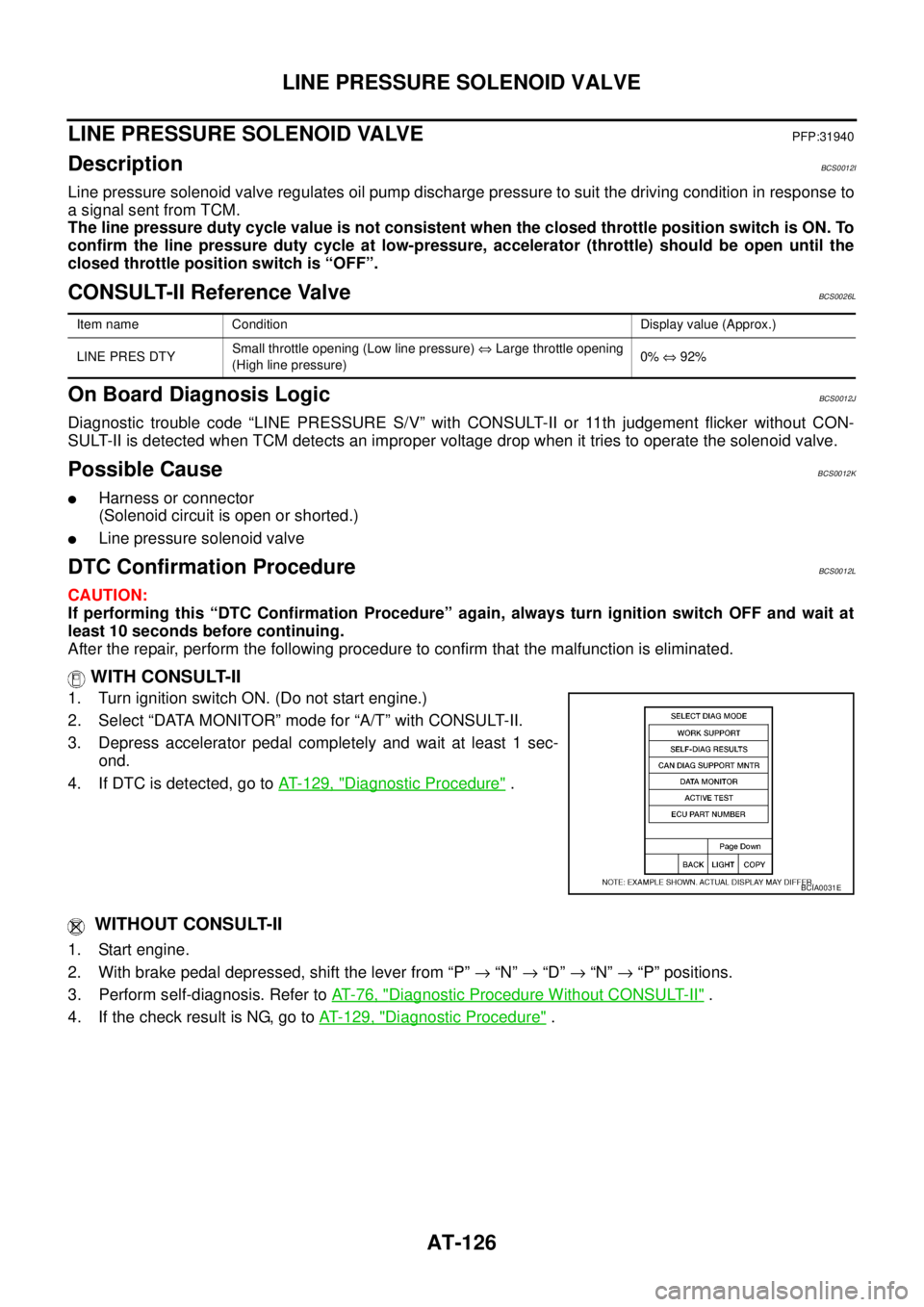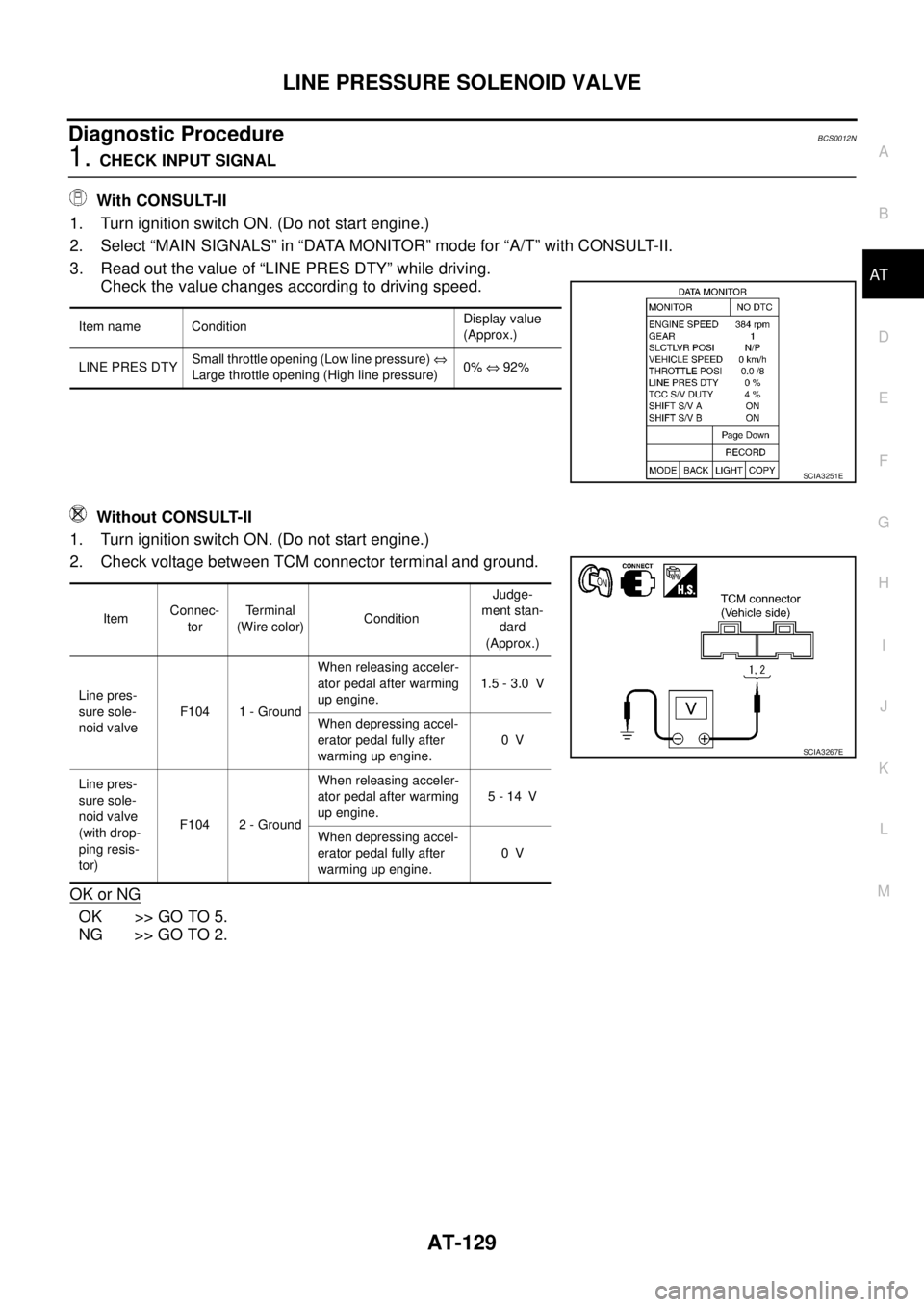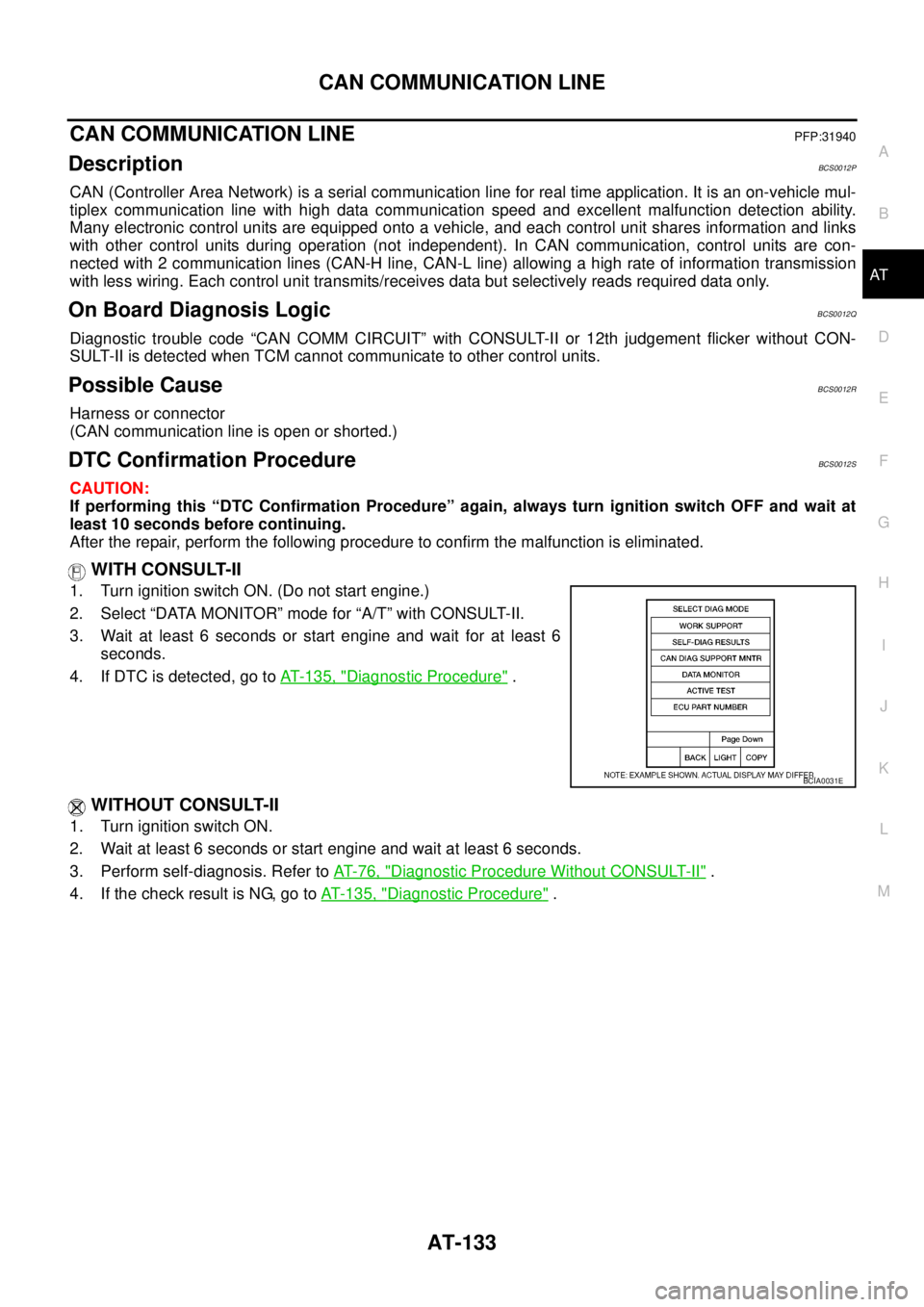Page 131 of 3502

TURBINE REVOLUTION SENSOR
AT-123
D
E
F
G
H
I
J
K
L
MA
B
AT
3. CHECK POWER AND SENSOR GROUND
1. Turn ignition switch OFF.
2. Disconnect the turbine revolution sensor (power train revolution sensor) harness connector.
3. Turn ignition switch ON. (Do not start engine.)
4. Check voltage between turbine revolution sensor (power train
revolution sensor) harness connector terminals.
5. Check voltage between turbine revolution sensor (power train
revolution sensor) harness connector terminal and ground.
6. If OK, check harness for short to ground and short power.
7. Reinstall any part removed.
OK or NG
OK >> GO TO 4.
NG - 1 >> Battery voltage is not supplied between terminals 1 and 3, terminals 1 and ground: GO TO 6.
NG - 2 >> Battery voltage is not supplied between terminals 1 and 3 only: GO TO 7.
4. CHECK HARNESS BETWEEN TCM AND TURBINE REVOLUTION SENSOR
1. Turn ignition switch OFF.
2. Disconnect the turbine revolution sensor (power train revolution sensor) harness connector.
3. Check continuity between TCM connector terminal and turbine
revolution sensor (power train revolution sensor) harness con-
nector terminal.
4. If OK, check harness for short to ground and short power.
5. Reinstall any part removed.
OK or NG
OK >> GO TO 5.
NG >> Repair open circuit or short to ground or short to power in harness or connectors.
Item Connector Terminal Data (Approx.)
Turbine revolution sensor
(power train revolution sensor)
harness connectorF38 1 - 3 Battery voltage
SCIA2770E
Item Connector Terminal Data (Approx.)
Turbine revolution sensor
(power train revolution sensor)
harness connectorF38 1 - ground Battery voltage
SCIA2771E
Item Connector Terminal Continuity
TCM connector F105 38
Ye s Turbine revolution sensor
(power train revolution sen-
sor) harness connectorF38 2
SCIA2772E
Page 134 of 3502

AT-126
LINE PRESSURE SOLENOID VALVE
LINE PRESSURE SOLENOID VALVEPFP:31940
DescriptionBCS0012I
Line pressure solenoid valve regulates oil pump discharge pressure to suit the driving condition in response to
a signal sent from TCM.
The line pressure duty cycle value is not consistent when the closed throttle position switch is ON. To
confirm the line pressure duty cycle at low-pressure, accelerator (throttle) should be open until the
closed throttle position switch is “OFF”.
CONSULT-II Reference ValveBCS0026L
On Board Diagnosis LogicBCS0012J
Diagnostic trouble code “LINE PRESSURE S/V” with CONSULT-II or 11th judgement flicker without CON-
SULT-II is detected when TCM detects an improper voltage drop when it tries to operate the solenoid valve.
Possible CauseBCS0012K
�Harness or connector
(Solenoid circuit is open or shorted.)
�Line pressure solenoid valve
DTC Confirmation ProcedureBCS0012L
CAUTION:
If performing this “DTC Confirmation Procedure” again, always turn ignition switch OFF and wait at
least 10 seconds before continuing.
After the repair, perform the following procedure to confirm that the malfunction is eliminated.
WITH CONSULT-II
1. Turn ignition switch ON. (Do not start engine.)
2. Select “DATA MONITOR” mode for “A/T” with CONSULT-II.
3. Depress accelerator pedal completely and wait at least 1 sec-
ond.
4. If DTC is detected, go to AT- 1 2 9 , "
Diagnostic Procedure" .
WITHOUT CONSULT-II
1. Start engine.
2. With brake pedal depressed, shift the lever from “P” → “N” → “D” → “N” → “P” positions.
3. Perform self-diagnosis. Refer to AT- 7 6 , "
Diagnostic Procedure Without CONSULT-II" .
4. If the check result is NG, go to AT- 1 2 9 , "
Diagnostic Procedure" .
Item name Condition Display value (Approx.)
LINE PRES DTYSmall throttle opening (Low line pressure) ⇔ Large throttle opening
(High line pressure)0% ⇔ 92%
BCIA0031E
Page 136 of 3502
AT-128
LINE PRESSURE SOLENOID VALVE
Data are reference value and are measured between each terminal and ground.
Terminal Wire color Item ConditionJudgement standard
(Approx.)
1 G/RLine pressure solenoid
valveWhen releasing accelera-
tor pedal after warming up
engine.1.5 - 3.0 V
When depressing acceler-
ator pedal fully after warm-
ing up engine.0V
2W/BLine pressure solenoid
valve (with dropping
resistor)When releasing accelera-
tor pedal after warming up
engine.5 - 14 V
When depressing acceler-
ator pedal fully after warm-
ing up engine.0V
Page 137 of 3502

LINE PRESSURE SOLENOID VALVE
AT-129
D
E
F
G
H
I
J
K
L
MA
B
AT
Diagnostic ProcedureBCS0012N
1. CHECK INPUT SIGNAL
With CONSULT-II
1. Turn ignition switch ON. (Do not start engine.)
2. Select “MAIN SIGNALS” in “DATA MONITOR” mode for “A/T” with CONSULT-II.
3. Read out the value of “LINE PRES DTY” while driving.
Check the value changes according to driving speed.
Without CONSULT-II
1. Turn ignition switch ON. (Do not start engine.)
2. Check voltage between TCM connector terminal and ground.
OK or NG
OK >> GO TO 5.
NG >> GO TO 2.
Item name ConditionDisplay value
(Approx.)
LINE PRES DTYSmall throttle opening (Low line pressure) ⇔
Large throttle opening (High line pressure)0% ⇔ 92%
SCIA3251E
ItemConnec-
torTerminal
(Wire color)ConditionJudge-
ment stan-
dard
(Approx.)
Line pres-
sure sole-
noid valveF104 1 - GroundWhen releasing acceler-
ator pedal after warming
up engine.1.5 - 3.0 V
When depressing accel-
erator pedal fully after
warming up engine.0V
Line pres-
sure sole-
noid valve
(with drop-
ping resis-
tor)F104 2 - GroundWhen releasing acceler-
ator pedal after warming
up engine.5 - 14 V
When depressing accel-
erator pedal fully after
warming up engine.0V
SCIA3267E
Page 138 of 3502
AT-130
LINE PRESSURE SOLENOID VALVE
2. CHECK DROPPING RESISTOR
1. Turn ignition switch OFF.
2. Disconnect dropping resistor harness connector in engine room.
3. Check resistance between terminals.
OK or NG
OK >> GO TO 3.
NG >> Repair or replace damaged parts.
3. CHECK VALVE RESISTANCE
1. Turn ignition switch OFF.
2. Disconnect terminal cord assembly connector in engine room.
3. Check resistance between terminal cord assembly harness con-
nector terminal and ground.
OK or NG
OK >> GO TO 4.
NG >> Repair or replace damaged parts.
Item Connector TerminalResistance
(Approx.)
Dropping resistor harness
connectorF39 1 - 2 12 Ω
SCIA4950E
Solenoid valve Connector Terminal Resistance (Approx.)
Line pressure solenoid
valveF43 4 - Ground 2.5 - 5.0 Ω
SCIA4951E
Page 141 of 3502

CAN COMMUNICATION LINE
AT-133
D
E
F
G
H
I
J
K
L
MA
B
AT
CAN COMMUNICATION LINEPFP:31940
DescriptionBCS0012P
CAN (Controller Area Network) is a serial communication line for real time application. It is an on-vehicle mul-
tiplex communication line with high data communication speed and excellent malfunction detection ability.
Many electronic control units are equipped onto a vehicle, and each control unit shares information and links
with other control units during operation (not independent). In CAN communication, control units are con-
nected with 2 communication lines (CAN-H line, CAN-L line) allowing a high rate of information transmission
with less wiring. Each control unit transmits/receives data but selectively reads required data only.
On Board Diagnosis LogicBCS0012Q
Diagnostic trouble code “CAN COMM CIRCUIT” with CONSULT-II or 12th judgement flicker without CON-
SULT-II is detected when TCM cannot communicate to other control units.
Possible CauseBCS0012R
Harness or connector
(CAN communication line is open or shorted.)
DTC Confirmation ProcedureBCS0012S
CAUTION:
If performing this “DTC Confirmation Procedure” again, always turn ignition switch OFF and wait at
least 10 seconds before continuing.
After the repair, perform the following procedure to confirm the malfunction is eliminated.
WITH CONSULT-II
1. Turn ignition switch ON. (Do not start engine.)
2. Select “DATA MONITOR” mode for “A/T” with CONSULT-II.
3. Wait at least 6 seconds or start engine and wait for at least 6
seconds.
4. If DTC is detected, go to AT- 1 3 5 , "
Diagnostic Procedure" .
WITHOUT CONSULT-II
1. Turn ignition switch ON.
2. Wait at least 6 seconds or start engine and wait at least 6 seconds.
3. Perform self-diagnosis. Refer to AT- 7 6 , "
Diagnostic Procedure Without CONSULT-II" .
4. If the check result is NG, go to AT- 1 3 5 , "
Diagnostic Procedure" .
BCIA0031E
Page 143 of 3502
CAN COMMUNICATION LINE
AT-135
D
E
F
G
H
I
J
K
L
MA
B
AT
Data are reference value and are measured between each terminal and ground.
Diagnostic ProcedureBCS0012U
1. CHECK CAN COMMUNICATION CIRCUIT
With CONSULT-II
1. Turn ignition switch ON. (Do not start engine.)
2. Select “SELF-DIAG RESULTS” mode for “A/T” with CONSULT-
II.
Is any malfunction the
“CAN COMM CIRCUIT” indicated?
YES >> Print out CONSULT-II screen, go to LAN-49, "CAN Sys-
tem Specification Chart" .
NO >>INSPECTION END
Terminal Wire color Item ConditionJudgement standard
(Approx.)
5L CAN-H — —
6 P CAN-L — —
SCIA7135E
Page 144 of 3502

AT-136
A/T 1ST GEAR FUNCTION
A/T 1ST GEAR FUNCTIONPFP:31940
DescriptionBCS00131
�This malfunction will not be detected while A/T CHECK indicator lamp is indicating another self-diagnosis
malfunction.
�This malfunction is detected when the A/T does not shift into first gear position as instructed by TCM. This
is not caused by electrical malfunction (circuits open or shorted) but by mechanical malfunction such as
control valve sticking, improper solenoid valve operation, etc.
On Board Diagnosis LogicBCS00132
�This diagnosis monitors actual gear position by checking the torque converter slip ratio calculated by TCM
as follows:
Torque converter slip ratio = A x C/B
A: Output shaft revolution signal from revolution sensor
B: Engine speed signal from ECM
C: Gear ratio determined as gear position which TCM supposes
If the actual gear position is higher than the position (1st) supposed by TCM, the slip ratio will be more
than normal. In case the ratio exceeds the specified value, TCM judges this diagnosis malfunction.
This malfunction will be caused when either shift solenoid valve A is stuck open or shift solenoid valve B is
stuck open.
�Gear positions supposed by TCM are as follows.
In case of gear position with no malfunctions: 1 , 2, 3 and 4 positions
In case of gear position with shift solenoid valve A stuck open: 2* , 2, 3 and 3 positions
In case of gear position with shift solenoid valve B stuck open: 4* , 3, 3 and 4 positions to each gear posi-
tion above
*: “A/T 1ST GR FNCTN” is detected.
�Diagnostic trouble code “A/T 1ST GR FNCTN” with CONSULT-II is detected when A/T cannot be shifted
to the 1st gear position even if electrical circuit is good.
Possible CauseBCS00133
�Shift solenoid valve A
�Shift solenoid valve B
�Each clutch
�Hydraulic control circuit
Gear position 1 2 3 4
Shift solenoid valve A ON (Closed) OFF (Open) OFF (Open) ON (Closed)
Shift solenoid valve B ON (Closed) ON (Closed) OFF (Open) OFF (Open)